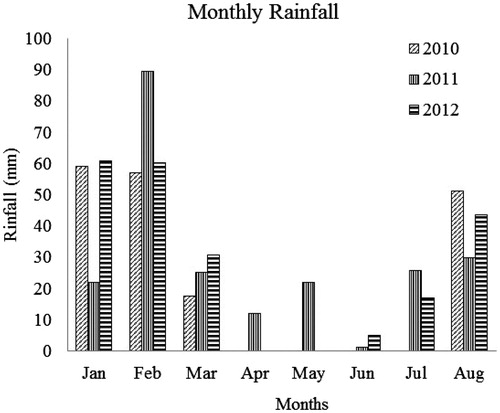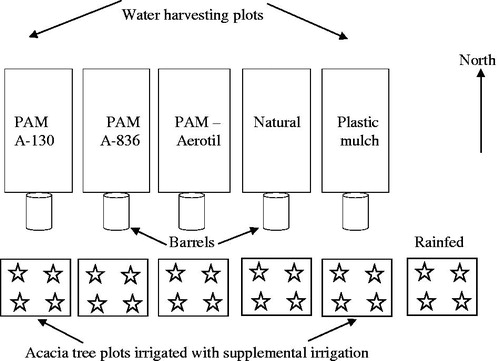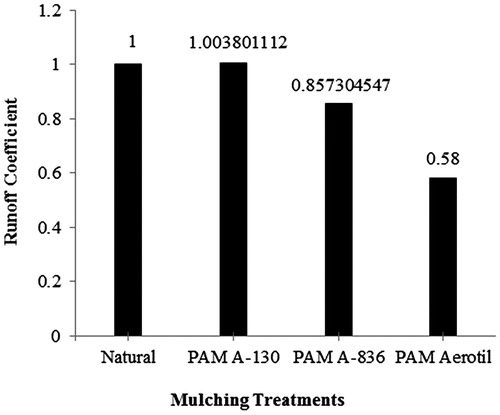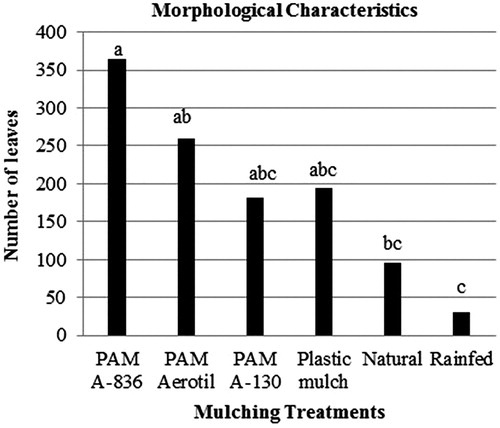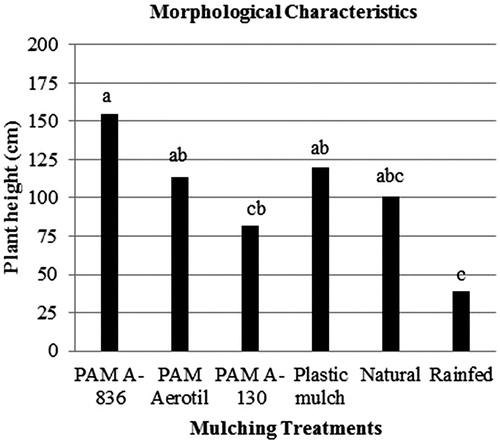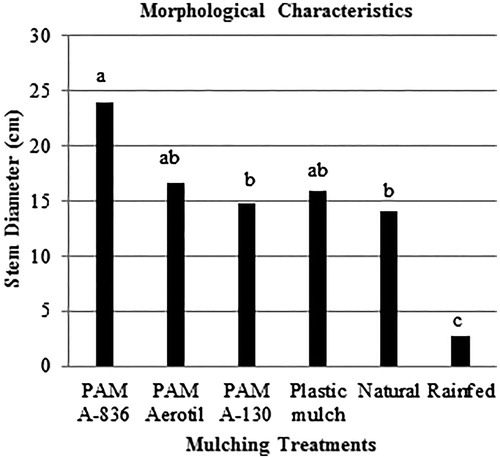Abstract
A field study was carried to determine the impact of the land application of polyacrylamide (PAM) on the runoff used for supplemental irrigation. Five treatments were investigated: PAM A-130, PAM A-836, PAM Aerotil, plastic mulch, and natural (no PAM no mulch). Runoff was collected in barrels placed at the downstream end of fifteen plots and then used for the irrigation of acacia trees planted in an experimental site in Jordan. The growth characteristics of the acacia were monitored over a two-year period from 2009 to 2010. The total runoff volumes were significantly different over PAM A-836, PAM Aerotil, and plastic mulch compared to the natural. The results showed that supplemental irrigation of acacia with water collected from PAM plots significantly increased the acacia height and number of leaves compared to the natural and rainfed treatments. The use of PAM-treated runoff also slightly increased the number of branches of the acacia, but the increase was only significant in the case of PAM A-836. There was a weak correlation between the volume of supplemental irrigation generated and the morphological characteristics. The type of PAM seems to have improved plant growth irrespective of the volume of runoff collected.
Introduction
Water is the limiting factor affecting agricultural production in dry areas (Oweis and Hachum Citation2006) that characterized by low annual rainfall and high potential evaporation. Jordan is one of the driest countries in the world in terms of water supply and 90% of the country receives less than 100 mm of annual rainfall. Rainfed agriculture is practiced in a narrow mountainous area located along eastside of the Jordan River valley. The annual rainfall in this area varied between 200 and 600 mm per year making suitable for production of fruit trees and cash crops. Pine and acacia forests, which represent only 1% of Jordan area, are found in those areas and depend on rainfall for survival. However, due to rainfall decrease and variability, forests areas in Jordan have decreased by 50% in the last 10 years. There are urgent needs to protect the existing forest areas and improve afforestation by adopting soil and moisture conservation techniques, such as rainwater harvesting.
Rainwater harvesting for tree production is to create microcatchment area around trees so that rainwater falling on this area is directed toward the planting area thus increasing the depth of infiltrated water in the planting area (Tubeileh et al. Citation2016). In some cases rainwater from the microcatchment is collected and used as supplemental irrigation making it possible to quantify the additional water added for production (FAO (Food and Agriculture Organization of the United Nations) Citation2016; Oweis and Hachum Citation2006). Despite rainfall shortages, rainwater harvesting in Jordan has not been widely practiced by farmers. Several national projects have constructed rainwater-harvesting techniques for demonstration purposes; But those techniques were not welcomed by local officials mainly because they are not convinced of their efficiency in improving growth and productivity.
This study was conducted to investigate the effect of land application with some variants of an organic polymer such as polyacrylamide (PAM), on the volume of runoff generated by microcatchments and consequently on the amount of supplemental irrigation obtained and acacia growth. PAM has been long used to control soil erosion in furrow irrigation (Sojka and Lentz Citation1997). In Jordan, Abu-Zreig et al. (Citation2007) have shown that land application of PAM highly reduced soil loss and slightly improve infiltration and vegetation cover in rainfed areas.
This research is designed to demonstrate the influence of supplemental irrigation resulted from rainfall harvesting on the growth of forest trees through long-term field experiment. Several researchers (Xiao et al. Citation2007; Wang et al. Citation2008) have shown that rainwater harvesting and supplemental irrigation has been shown to increase the water content of the soil, reduce soil erosion, and increase vegetation cover in dry lands, thus combating desertification. Wang et al. (Citation2008) reported several advantages of using microcatchments for rainwater harvesting, including increasing soil moisture and crop yield. On the other hand, harvested water can be stored and then used for supplemental irrigation of crops and trees especially forest tress. In semi-arid areas of China, Xiao et al. (Citation2007) found that, 40 and 59 mm of supplemental irrigation during the of rainfed wheat can increase the yield by 30%. Crop production using rainwater harvesting and supplemental irrigation is one of the best ways of improving survival and growth of forest trees in arid regions and Jordan in particular.
Acacia saligna has a long history in multipurpose use in the arid zone ecosystem in Australia. This species is capable of developing into a robust woody shrub or small tree, growing on a wide range of soils and producing a good quality of woody biomass. It has a long history of being used for site rehabilitation, revegetation, in agroforestry, amenity plantings, and as a fodder plant for stock (Khanzada et al. Citation1998).
The main objectives of this study is to test the impact of PAM on the rain-runoff volume. And, the impact of the runoff volume, which generated under the PAM-treated microcatchments on the growth characteristics of acacia under arid conditions. Where, the soil of experimental area is characterized as shallow, sloppy, and crusty with low infiltration rate.
Materials and methods
Experimental site
The experimental site is located on the campus of Jordan University of Science and Technology in the northern part of Jordan, latitude 36° 34′ N, longitude 36° 01′ E, altitude 520 m. The site is located in an arid region, hot in summer and cool in winter with an average annual precipitation of 220 mm/year. The 10 years average rainfall distribution and that for the 2009, 2010 and 2011 (). The soil is shallow and characterized as clay loam. The soil properties are presented in . The main native species grown in the experimental area are Convolvulus drocynum, Avena sterilis, Anchusa aegyptiaca, Hordeum spontaneum, Stipa capensis, and Erucaria hispanica.
Table 1. The physical and chemical soil properties for the experimental area.
Table 2. Runoff volume (L) generated by PAM-treated, plastic mulch and natural plots.
Rainfall-runoff plots
The experiments were conducted using three sets of five rectangular plots (). Each plot measured 2 × 10 m. The slope of the plots was about 12%. A barrel of 130-liter capacity was installed at the down end of each plot below the soil surface to collect the rainfall runoff. A ridge 15 cm in height and made of stones surrounded the border of each plot to prevent any intermixing of the different runoffs from the plots. The depth of rainfall storms that occurred during the field study periods were recorded and the runoff in the barrels was collected for each storm one time per day or sometimes twice per day when the rainstorms continued for more than a day and recorded. A rain gauge was installed in the experimental area to measure the daily rainfall at the site. Field measurements were conducted during the months of November to July in three consecutive years, 2009, 2010, and 2011.
PAM treatments
The experiment was designed to investigate the effect of five land surface practices. These practices were the land application of PAM A-836, PAM Aerotil, PAM A-130, and plastic mulch, and natural plots (no PAM no mulch). For the treatments, PAM was dissolved in water (2 gm/l), agitated thoroughly, and left for 48 h. Then, it was applied at a rate of 2 gm/l/m2. The plots were cleared of stones and compacted by a heavy roller so that the soil surface was made smooth before the addition of the PAM mixture. The mixture of PAM was sprayed over the plots by using a screen barrel of 20-liter capacity.
Planting plots
Three meters below each runoff plot, a 9 m2 plot was constructed in which four Acacia saligna trees (one year old seedlings) were transplanted directly using traditional method (). The planting plots were each divided into four equal squares (1.5 × 1.5 m2), one square for each tree. Each of the squares was bordered by a 15 cm high ridge to confine the water applied on each plant. The water harvested from each runoff plot was collected from the barrel, divided equally among the four trees, and applied manually with a bucket. Near to the three sets of five irrigated plots, another plot measuring 9 m2 was constructed, in which six trees were planted as a control. The plot was located in the same field so that the slope, soil type, and soil depth were similar. These control plants only receive rainwater falling over their planting basin area without supplemental irrigation. The tree leaves, height, branches, and stem diameter at a height of 15 cm from the ground surface were measured using a ruler and a caliper once in duration of 1–2 months for all treatments. The morphological data on the acacia trees, 66 trees in total, were statistically analyzed for variance using SAS Software version 9.0 (SAS, Citation2002) and the means were compared by using the least significance difference (LSD) at p ≤ .05. The data on the runoff of different treatments were analyzed using LSD test to compare the means among the treatments at probability level of .05.
Results and discussion
Rainfall-runoff characteristics
The rainfall and runoff volumes for the different treatments of PAM A-130, PAM A-836, PAM Aerotil, natural plots, and plastic mulch are presented in . Rainfall storms and the volume of collected rain for each plot were monitored for three years 2009, 2010, and 2011. A rain gauge installed at the experimental site measured the rainfall amount. Twenty-four storms were recorded and analyzed during the three years of study; ten storms in 2009, six storms in 2010, and eight storms in 2011. The total rainfall depth recorded during the three years was 318.2 mm and most of the rainfall storms occurred during the period from December to April. The minimum rainfall depth was 0.3 mm occurred on 13th December, 2009 and the maximum rainfall depth was 47.0 mm on 1st March, 2010. Runoff was not observed for few storms that had a rainfall depth of less than 6.5 mm, 10.0 mm, and 1.9 mm during 2009, 2010, and 2011, respectively.
The largest total runoff volumes recorded over the three years (2009, 2010, and 2011) were found for the plastic mulch, PAM A-130 and natural plots, 1653.0 L, 511.5 L and 509.5 L, respectively. The corresponding runoff volumes for the PAM-treated plots were almost lower as shown in . The runoff collected from the plastic mulch plots seemed to be smaller than expected, based on rainfall depth, because in some cases we were unable to monitor long-duration storms that generate runoff volume greater than the capacity of collection barrels resulting in water overflow. Nevertheless, the data from the natural plots were used to undertake a comparative analysis among runoff volumes across the treatments.
The runoff volumes for PAM Aerotil and PAM A-836 were similar but less than that for the natural and PAM A-130 plots. Therefore, water infiltration depths seemed to increase with PAM treatment in the following order Aerotil > PAM A-836 > PAM A-130. These results are in agreement with a study conducted by Abu-Zreig (Citation2006).
Runoff coefficients for PAM-treated plots compared to natural plots is presented in . Runoff ratios were the highest for the PAM A-130 treatment and lowest for the plots treated with PAM Aerotil implying high infiltration rate for PAM Aerotil plots followed PAM A-836 and PAM A-130 treated plots.
Morphological characteristics
Growth characteristics of acacia were carried out for the supplemental irrigated plots using runoff generated from the areas treated with PAM A-130, PAM A-836, PAM Aerotil, plastic mulched area, natural areas and rainfed plots. Acacia trees showed variation in growth characteristics as a result of the quantity of water harvested and collected from the above land treated practices. The final number of acacia leaves under different treatments is presented in . Among all the treatments, the number of leaves of acacia were the lowest for natural plots and rainfed plots. In the case of the PAM treatments, PAM A-836 produced the highest number of leaves and plant height followed by PAM Aerotil and PAM A-130 even though runoff used for supplemental irrigation was the highest from the plastic mulch plots. The number of leaves responses to runoff generated from treated plots was in the order of PAM A-836 (365 leaves) > PAM Aerotil > plastic mulch > PAM A-130, (182 leaves) > natural > rainfed.
The height of acacia trees under different treatments is presented in . Acacia height increased in the following order: PAM A-836 (155.0 cm)> plastic mulch (120 cm)> PAM Aerotil > PAM A-130 > natural > rainfed. However, the differences among the treatments was not significantly different at p ≤ .05. In general, the height of acacia trees receiving supplemental irrigation with runoff collected from the PAM A-836 plots was not significantly different from that for the PAM Aerotil, plastic mulch, and natural plots, but it was significantly different from that for the PAM A-130 and rainfed plots. The lowest acacia height of 40 cm was found in the rain fed plots and this was significantly lower than that produced by the PAM treatments.
The stem diameter was significantly different under the six treatments (). The largest stem diameter (24 cm) was produced under PAM A-836 and the rainfed plots produced the lowest (3 cm). The number of acacia branches was not significantly different under the six treatments. However, the branches increased in the order of PAM A-836 > plastic mulch > PAM Aerotil > PAM A-130 > natural > rainfed. The number of branches varied from 13 under PAM A-836 to five under the rainfed plots. In general, the number of branches and stem diameter of the acacia irrigated by water harvested from the plastic-mulched plots were not different from those irrigated by water from the PAM-treated plots.
Previous analysis revealed that the morphological parameters of acacia irrigated by runoff from the PAM-treated plots were better than the natural and rainfed plots. However, an increase in the depth of supplemental irrigation did not further improve the growth parameters, i.e. number of leaves, tree height, stem diameter, and branches, significantly. The values of the morphological parameters produced by the runoff generated under PAM A-836 were greater than those under PAM Aerotil and PAM A-130, yet the amount of runoff volume from PAM A-836 (436.8 L) was greater than that from PAM Aerotil (306.9 L) and less than that from PAM A-130 (511.5 L). This study found that a weak correlation between the morphological characteristics of acacia and the increase in the supplemental irrigation amount. This relationship between the morphological parameters and the runoff may have been influenced by the subsurface flow of water because the soil depth at the experiment site is shallow (∼0.5 m) and the slope is high (12%). In addition, increasing the amount of applied water beyond certain limit will not be utilized by trees during the rainy season. Tadros (Citation2003) indicates that dry biomass increases with the amount of water applied only until 550 mm.
A weak correlation was found between the morphological characteristics and the quantity of supplemental irrigation. Our results seemed to be supported by Sher et al. (Citation2010) who indicated that acacia trees mostly use surface water and have a low tolerance to the saline conditions. Millions of acacia trees have been dying due to flooding and water-logging in Bangladesh. However, scant research has been conducted to identify the causes of tree deaths and to find suitable practices to reduce the impact of floods on trees (Basak et al. Citation2015). On the other hand (Kaiser Citation1987; Okello et al. Citation2001) show that increasing the supplemental irrigation level increases plant growth due to the increase in photosynthetic activity. Leaf growth and shoot elongation depend on the availability of water in the soil and the plant-tissue water status (Otieno et al. Citation2005). They also indicated that the ratio of sap flux to equilibrium evaporation has been found to be negatively correlated with the depth of the water table in forests that are place to woody native species such as eucalyptus (Yoshiyuki et al. Citation2014). Our findings presented in here demonstrated that the effect of PAM on the morphological characteristics of acacia is significant. Despite the fact that PAM-treated plots produced less runoff, they increased acacia growth more than the natural and rainfed plots. It seems that the presence of a PAM solution in runoff water enhances acacia growth significantly. These observed results imply that the land application of PAM on agricultural fields may have a beneficial effect on crop growth in addition to its positive effect on soil stability and soil erosion.
Conclusions
This study investigating the impact of land application of PAM on the runoff volume. Rainwater harvesting from microcatchment under application of three types of PAM’s (PAM-130, PAM-836, PAM Aerotil), natural treatment (without PAM), and a plastic mulch was collected. And, it was used as a supplemental irrigation for irrigating acacia trees in arid land. The amount of rainwater harvesting collected under the treatment was varied from one to another. The largest amount of rainwater harvesting was collected from the plastic-mulched plots followed by the PAM A-130, natural, PAM A-836, and PAM Aerotil plots, respectively. The effect of using the rainwater harvesting under the experimental treatments on acacia growth characteristics was compared with that under rainfed conditions. The number of leaves, branches, height, and stem diameter of acacia increased tenfold under some treatments compared to their rainfed counterparts. However, the growth of the acacia irrigated with runoff from PAM A-836 treated plots was found to be significantly better than that with plastic-mulched plots, although the amount of runoff produced from plastic mulch plots were three times higher. Also, the growth of acacia that were irrigated by water from the PAM plots was better than those irrigated by water harvested from the natural plots, yet the amount of water collected was similar. In light of these findings, we believe that the presence of PAM solution in irrigation water can further improve the growth and morphological characteristics of acacia.
Acknowledgments
The authors would like to thank the Jordan University of Science and Technology for supporting this research. We also express our thanks for the laboratory assistance provided by Mohammad Bashabesha and Amal Al-Omari who helped with the data collection.
Disclosure statement
No potential conflict of interest was reported by the authors.
References
- Abu-Zreig M. 2006. Control of rainfall induced soil erosion with various types of polyacrylamide. J Soils Sediments. 6(3):137–144.
- Abu-Zreig M, Al-Sharif M, Amayreh J. 2007. Erosion control of arid land in Jordan with two anionic polyacrylamides. Arid Land. Res and Manag. 21(4):315–328.
- Basak SR, Basak AC, Rahman MA. 2015. Impact of floods on forest and their coping strategies in Bangladesh. Weather Clim Extrem. 7:43–48.
- FAO (Food and Agriculture Organization of the United Nations). 2016. Assessment of the water-harvesting sector in Jordan. In the final report prepared by: Maher Salman, Motasem Abu Khalaf, Brenna Moore; 1–43. www.fao.org/publications.
- Kaiser WM. 1987. Effect of water deficit on photosynthetic capacity. Physiol Plant. 71(1):142–149.
- Khanzada AN, Morris JD, Ansari R, Slavich PG, Collopy JJ. 1998. Groundwater uptake and sustainability of Acacia and Prosopis plantations in Southern Pakistan. Agric Water Manag. 36(2):121–139.
- Okello B, O’Connor D, Young TP. 2001. Growth, biomass estimates, and charcoal production of Acacia drepanolobium in Laikipia, Kenya. For Ecol and Manage. 142(1–3):143–153.
- Otieno DO, Schmidt MWT, Kinyamario JI, Tenhunen J. 2005. Response of Acacia tortilis and Acacia xanthophloea to seasonal changes in soil water availability in the savanna region of Kinya. J Arid Environ. 62(3):377–400.
- Oweis T, Hachum A. 2006. Water harvesting and supplementary irrigation for improved water productivity of dry farming systems in West Asia and North Africa. Agric Water Manag. 80(1–3):57–73.
- SAS. 2002. The SAS System for Windows version 9.0. Cary, NC, USA: SAS Institute.
- Sher AA, Wiegand K, Ward D. 2010. Do Acacia and Tamarix trees compete for water in the Negev Desert? Arid Environ. 74(3):338–343.
- Sojka RE, Lentz RE. 1997. Reducing furrow irrigation erosion with polyacrylamide (PAM). J Prod Agric. 10(1):47–52.
- Tadros MJ. 2003. The physiology and biochemistry of the multipurpose forest tree species: Luecaena leucocephala (Lam.) De Wit, Prosopis juliflora (Swartz) DC, Acacia saligna (Labill.), and Eucalyptus citriodora (Hook f.) as influenced by water stress. Ph.D thesis. West Lafayette, IN, USA: Purdue University.
- Tubeileh A, Bruggeman A, Turkelboom F. 2016. Water-harvesting designs for fruit tree production in dry environments. Agric Water Manag. 165:190–197.
- Wang Q, Zhang E, Fengmin L, Fengrui L. 2008. Runoff efficiency and the technique of micro-water harvesting with ridges and furrows, for potato production in semi-arid areas. Water Resour Manag. 22:1431–1443.
- Xiao G, Zhang Q, Xiong Y, Lin M, Jing W. 2007. Integrating rainwater harvesting with supplementary irrigation into rain-fed spring wheat farming. Soil Tillage Res. 93(2):429–437.
- Yoshiyuki M, Makiko T, Hikaru K, Vuthy M, Tsuyoshi K, Heng S, Nobuya M, Tomo’omi K. 2014. Tropical tree water under seasonal waterlogging and drought in Central Cambodia. J Hydrol. 5:81–89.

